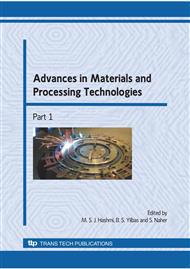p.866
p.874
p.881
p.889
p.896
p.904
p.914
p.923
p.931
Structure and Properties of High-Chromium-Alloyed Upper-Eutectoid Steels after Hardening with Concentrated Energy Fluxes
Abstract:
The present paper deals with the structure and properties of two types of tool steels with high chromium content (12% Cr) hardened by means of Concentrated Energy Fluxes (CEF). The treatment conditions are chosen to ensure liquid state transformations. The melted zone of the surface layer features a quasi-ledeburite structure, consisting of inhomogeneous residual austenite and Cr-containing carbides of MmCn type. This austenite is strongly cold hardened and over-saturated with Cr and carbon. The micro-hardness of this region varies from 400 up to 800 HV0.1. The higher the energy density, the lower the hardness and the wider the modified layers. The lower hardness is due to the presence of nearly 100% austenite. Higher hardness was obtained in the heat affected zone. Carbides of M23C6, M7C3, M6C, M3C and МС types were identified. A scheme of carbide changes after treatment with CEF is given.
Info:
Periodical:
Pages:
896-903
Citation:
Online since:
December 2009
Authors:
Price:
Сopyright:
© 2010 Trans Tech Publications Ltd. All Rights Reserved
Share:
Citation:


